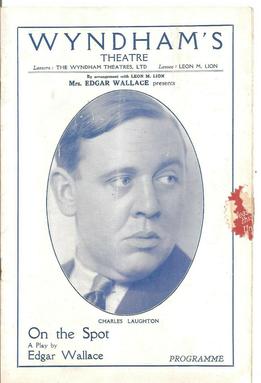Superintendent Battle is a fictional character created by Agatha Christie who appeared in five of her novels.
The Man Who Changed His Name is a mystery play by the British writer Edgar Wallace, which was first staged in 1928. A young woman begins to suspect that her wealthy, respectable husband may be an escaped Canadian murderer.

Go Back for Murder is a 1960 mystery play by the British writer Agatha Christie. It is an adaptation of her 1942 novel Five Little Pigs, with the principal character of the book Hercule Poirot removed from the story. Much of the detective work is taken over by Carla Crale, daughter of the murder victim, with the assistance of Justin Fogg a lawyer.

On the Spot is a 1930 Chicago-set play by the British writer Edgar Wallace. Wallace was inspired by a visit to the United States and, in particular, the Saint Valentine's Day Massacre. Known as a prolific author, he reportedly dictated the manuscript for the play in just four days. It was his greatest theatrical success.
The Calendar is a 1929 play by the British writer Edgar Wallace. It is a crime thriller set in the world of horse racing world, the sport being among Wallace's interests. The protagonist is a financially struggling racehorse owner with a shady reputation. It premiered at the Palace Theatre in Manchester before transferring to Wyndham's Theatre in the West End.
The Mouthpiece is a 1930 crime play by the British writer Edgar Wallace. It was one of several theatrical failures written by Wallace following the enormous success of On the Spot, with a plot described as "flimsy".
The Old Man is a 1931 mystery play by the British writer Edgar Wallace. Its original production was staged at Wyndham's Theatre in London's West End for a ninety performance run. It is set entirely in the "Coat of Arms" tavern where a mysterious old man lurks in the background, reputedly an escapee from a lunatic asylum. The original cast included Alfred Drayton, Jack Melford, Harold Warrender and Finlay Currie.
Persons Unknown is a 1929 mystery play by the British writer Edgar Wallace. The plot revolves around the murder of a "person unknown" in a street by a mysterious blackmailer. It features the character of Sergeant Elk, a Scotland Yard detective who appeared in several of Wallace's novels.
M'Lady is a 1921 play by the British writer Edgar Wallace. It is a drama about a woman who tries to raise her daughter in high society, only for her husband to return from Broadmoor where he has been serving a sentence for killing a police officer. It was panned by theatre critics.
The Terror is a 1927 mystery thriller play by the British writer Edgar Wallace. It is based on Wallace's 1926 novel The Black Abbot.
Smoky Cell is a thriller play by the British writer Edgar Wallace first staged in 1930. In America a group of detectives hunt down a notorious racketeer.
Somebody Knows is a 1932 mystery play by the British writer John Van Druten about an entertainer who is accused of strangling a prostitute. Following a court case there is not enough evidence to convict him, leaving the audience unsure of his actual guilt.
None But the Brave is a 1925 farcical melodramatic play by the British writers Bernard Merivale and Brandon Fleming in which a man inherits the estate of a wealthy uncle, and has to avoid being framed for murder by his relatives.

Blondie White is a 1937 mystery play by British writer Jeffrey Dell and Bernard Merivale. A murder mystery, it was inspired by an earlier play by Hungarian writer Ladislas Fodor. A famous crime novelist helps Scotland Yard to solve the murder of a nightclub performer, Blondie White.

Someone Waiting is a 1953 thriller play by the British writer Emlyn Williams.

The Amazing Dr. Clitterhouse is a 1936 thriller play by the British writer Barré Lyndon. The lead character's name is a play on the term for the female sexual organ the clitoris - a name characterised by the "yearning, untrammelled nature" of Clitterhouse himself; an extremely daring pun for 1936, yet seemingly anticipated by Lyndon to escape the notice of the contemporary censor. Lyndon wrote, "My view was that he was no more likely to locate the pun in my title as to locate the source of it on his beloved bedfellow".
The Romance of David Garrick is a 1942 historical play by the British writer Constance Cox.
Vanity Fair is a 1946 play by the British writer Constance Cox, based on William Makepeace Thackeray's novel of the same name.

Lord Arthur Savile's Crime is a 1952 comedy thriller play by the British writer Constance Cox, based on the short story Lord Arthur Savile's Crime by Oscar Wilde. After a palm reader convinces him it is his destiny to commit murder before he can marry his fiancée, an aristocrat makes several inept attempts to kill people.

Blackmail is a 1928 thriller play by the British writer Charles Bennett. In Chelsea, an artist's model kills an artist when he attempts to assault her.







